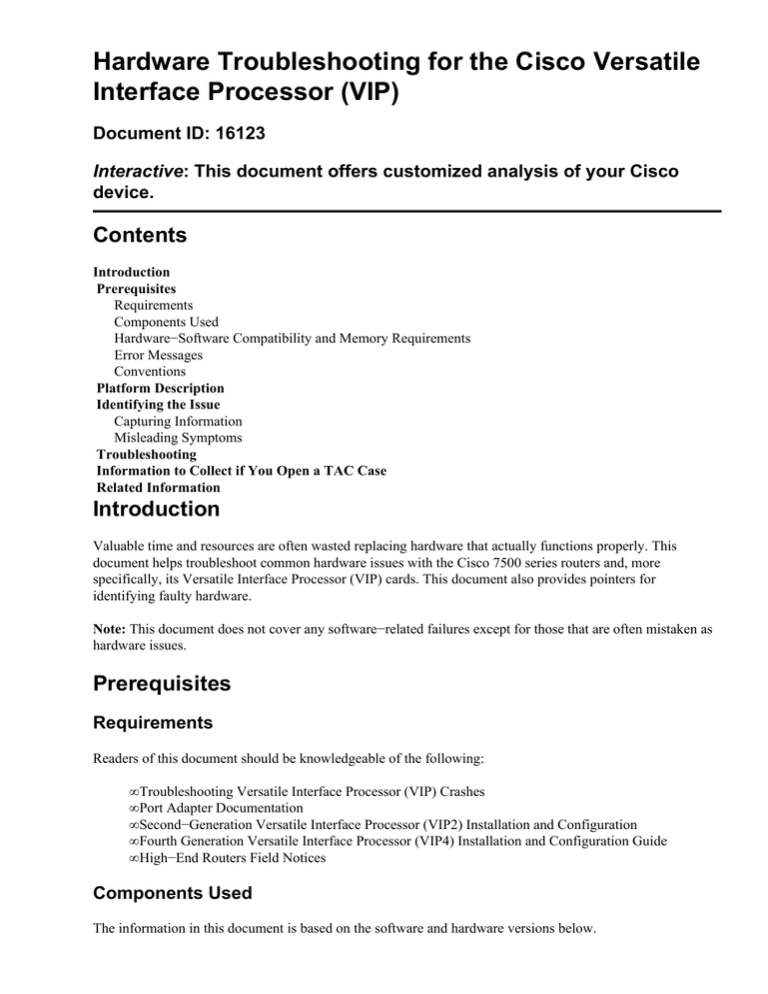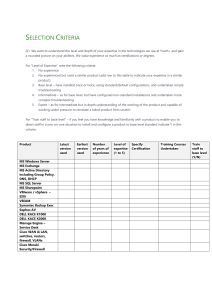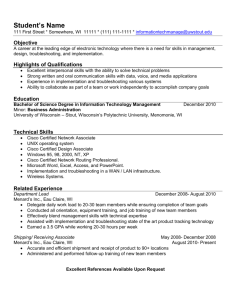
Hardware Troubleshooting for the Cisco Versatile
Interface Processor (VIP)
Document ID: 16123
Interactive: This document offers customized analysis of your Cisco
device.
Contents
Introduction
Prerequisites
Requirements
Components Used
Hardware−Software Compatibility and Memory Requirements
Error Messages
Conventions
Platform Description
Identifying the Issue
Capturing Information
Misleading Symptoms
Troubleshooting
Information to Collect if You Open a TAC Case
Related Information
Introduction
Valuable time and resources are often wasted replacing hardware that actually functions properly. This
document helps troubleshoot common hardware issues with the Cisco 7500 series routers and, more
specifically, its Versatile Interface Processor (VIP) cards. This document also provides pointers for
identifying faulty hardware.
Note: This document does not cover any software−related failures except for those that are often mistaken as
hardware issues.
Prerequisites
Requirements
Readers of this document should be knowledgeable of the following:
• Troubleshooting Versatile Interface Processor (VIP) Crashes
• Port Adapter Documentation
• Second−Generation Versatile Interface Processor (VIP2) Installation and Configuration
• Fourth Generation Versatile Interface Processor (VIP4) Installation and Configuration Guide
• High−End Routers Field Notices
Components Used
The information in this document is based on the software and hardware versions below.
• All Versatile Interface Processors (VIPs) for the Cisco 7500 Series Routers, including the following:
VIP Type
VIP2−10
VIP2−15
VIP2−40
VIP2−50
VIP4−50
VIP4−80
Description
Contains a (MIPS) R4600 CPU that runs at
100 MHz internally, 50 MHz external bus
speed and contains 8 MB memory
Contains a (MIPS) R4600 CPU that runs at
100 MHz internally, 50 MHz external bus
speed and contains 8 MB memory
Contains a (MIPS) R4600 CPU that runs at
100 MHz internally, 50 MHz external bus
speed and contains 16 MB memory
Contains a (MIPS) R5000 CPU that runs at
250 MHz internally, and supports memory
options from 32MB to 128MB
Contains a (MIPS) R5000 CPU and supports
memory options from 64MB to 256MB.
Memory is ECC−protected
Contains a (MIPS) R7000 CPU and supports
memory options from 64MB to 256MB.
Memory is ECC−protected.
Contains a (MIPS) R7000 CPU that runs at
400 MHz internally, and supports memory
options from 64MB to 256MB. Memory is
ECC−protected.
®
• All Cisco IOS software versions
VIP6−80
The information presented in this document was created from devices in a specific lab environment. All of the
devices used in this document started with a cleared (default) configuration. If you are working in a live
network, ensure that you understand the potential impact of any command before using it.
Hardware−Software Compatibility and Memory Requirements
Whenever you install a new RSP, VIP, port adapter, or Cisco IOS software image, it is important to verify that
the router has enough memory, and that the hardware and software are compatible.
Perform the following recommended steps to check for hardware−software compatibility and memory
requirements:
1. Use the Software Advisor (registered customers only) Tool to verify whether the modules and cards
are supported by the desired Cisco IOS software version.
2. Use the Cisco Download Software Area (registered customers only) to check the minimum amount of
memory (RAM and Flash) required by the Cisco IOS software, and/or download the Cisco IOS
software image. IN order to determine the amount of memory (RAM and Flash) installed, refer to
Memory Requirements.
Tips:
♦ In the Cisco IOS Upgrade Planner, you need to select the platform and the recommended
Cisco IOS software release from step 1 in order to view the memory requirements.
♦ If you need to upgrade the Cisco IOS software image to a new version, see How to Choose a
Cisco IOS Software Release for more information.
If you determine that a Cisco IOS software upgrade is required, follow the Software Installation and Upgrade
Procedures for the Cisco 7500 Series Router.
Error Messages
The Error Message Decoder (registered customers only) tool allows you to check the meaning of an error
message. Error messages appear on the console of Cisco products, usually in the following form:
%XXX−n−YYYY : [text]
Here is an example of an error message:
Router# %SYS−2−MALLOCFAIL: Memory allocation of [dec] bytes failed from [hex],
pool [chars], alignment [dec]
Some error messages are informational only, while others indicate hardware or software failures and require
action. The Error Message Decoder (registered customers only) tool provides an explanation of the message, a
recommended action (if needed), and if available, a link to a document that provides extensive
troubleshooting information about that error message.
Conventions
For more information on document conventions, see the Cisco Technical Tips Conventions.
Platform Description
This section covers the Versatile Interface Processor 2 (VIP2) and the Versatile Interface Processor 4 (VIP4)
for Cisco 7500 Series Routers.
Interface Processors (IPs), in general, contain the network interfaces for the Cisco 7500 Series Router. There
are two kinds of IPs:
• Legacy Interface Processors: These cards are considered to be non−intelligent compared to the VIPs
as they cannot make any packet switching decisions. Also, the entire card needs to be swapped out if
there is a need for a different interface.
Legacy interface processors do not contain dissimilar interfaces, meaning that you cannot have a
Token Ring interface with an Ethernet interface on the same legacy interface processor.
• Versatile Interface Processors (VIPs): VIPs are versatile, meaning that they can contain two
different interfaces. Thus, unlike the Legacy Interface Processor, the VIP can contain a Token Ring
and Ethernet interface on the same Interface Processor. These interfaces are built into the Port
Adapter (PA) which needs to be inserted on the VIP.
Changing an interface is as simple as swapping a PA. PAs come in two sizes: single−wide and
dual−wide. A single−wide PA takes up only one slot, whereas dual−wide PAs are twice the size of
single−wide PAs and fill two slots. A VIP can hold only one dual−wide PA.
If distributed switching is enabled on the router, the VIP can make packet switching decisions. This
decreases the load from the Route Switch Processor (RSP) and shifts it to the VIP.
In a distributed switching configuration environment, the RSP sends information such as routing table
updates to the VIP that is used to make switching decisions. VIPs are essentially routers on a blade
that allow the 7500 to be a distributed system in which switching decisions can be made on the VIP
instead of by the route processor.
Notes:
• Distributed switching is not available on VIP2−10s and VIP2−15s.
• There may be restrictions and limitations on which PAs can be inserted into a specific VIP. Consult
the product documentation listed below to verify that the combination is supported before you attempt
to implement it.
♦ For the VIP2 Series, see the VIP2 and Port Adapter Compatibility section of
Second−Generation Versatile Interface Processor (VIP2) Installation and Configuration.
♦ For the VIP4 Series, see the VIP4 and Port Adapter Compatibility section of the Fourth
Generation Versatile Interface Processor (VIP4) Installation and Configuration Guide.
Identifying the Issue
VIPs can reboot or reload for various reasons. Several of these are due to potential hardware issues. Below is
information on how to capture outputs helpful for troubleshooting and identifying misleading symptoms
caused by bad hardware. The troubleshooting steps for the symptoms are listed in the Troubleshooting section
below.
Capturing Information
In order to determine what is causing the issue, the first step is to capture as much information about the
problem as possible. The following information is essential to determining the cause of the problem:
• VIP crashinfo file(s) − When a VIP crashes, a file is saved into the bootflash of the primary RSP.
The crashinfo contains logs, memory dumps, and other vital information to facilitate the
troubleshooting. Detailed information on crashinfo can be found in Retrieving Information from the
Crashinfo File.
• RSP console logs and/or Syslog information − These are crucial in determining the originating issue
if multiple symptoms are occurring (this is usually the case when a VIP crashes or has other
problems). Effective troubleshooting can be done if the console log/syslog is made available. If the
router is set up to send logs to a syslog server, check the server for the log. For RSP console logs,
make sure you are directly connected to the console port of the router and Apply Correct Terminal
Emulator Settings for Console Connections. Ensure that logging is enabled.
• Output from the show diagbus command − When a VIP crashes, the reason for the latest crash may
be displayed in the show diagbus command. This information can be helpful in troubleshooting the
problem. This command is also part of the show technical−support command which may be
requested by the Cisco Technical Assistance Center (TAC).
If you have the output of a show command from your Cisco device (including show technical−support), you
can use to display potential issues and fixes. To use, you must be a registered customer, be logged in, and
have JavaScript enabled.
You can use Output Interpreter to display potential issues and fixes. To use Output Interpreter, you must be a
registered customer, be logged in, and have JavaScript enabled.
Misleading Symptoms
There are a few issues that can be misinterpreted as hardware problems when, in fact, they are not. For
instance, a failure following a new hardware installation is not always a hardware issue. The table below lists
symptoms, explanations, and troubleshooting steps for these commonly misinterpreted issues:
Symptom
The VIP is not
recognized when
installed, or it crashes on
bootup or Online
Insertion and Removal
(OIR) of a new VIP.
Output Stuck/Output
Frozen/Not Transmitting
error messages
The error message
"RSP−3−RESTART:
cbus complex"
A VIP running at very
high CPU utilization
VIP crashes
Memory Size Unknown
error message
Explanation
Use the Software Advisor (registered
customers only) tool to see if the VIP is
supported in your current Cisco IOS
software version. Also, make sure your
RxBoot image supports the VIP. The
background section of What Causes
"Bad CPU ID" Messages contains a
good explanation of the differences
between the main Cisco IOS software
image and the RxBoot image.
These error messages are usually
caused by software problems and are
discussed in detail in What Causes
%RSP−3−RESTART: interface [xxx],
output stuck/frozen/not transmitting
Messages?.
This error message may be due to
configuration changes, OIR of an
interface processor or other software,
or bad hardware issues. This error
message is discussed in detail in What
Causes a "%RSP−3−RESTART: cbus
complex"?.
This is very rarely caused by a
hardware issue. More information on
one of the most common reasons for
high VIP CPU utilization is discussed
in Understanding VIP CPU Running at
99% and Rx−Side Buffering.
Not all VIP crashes are caused by bad
hardware. Troubleshooting Versatile
Interface Processor (VIP) Crashes can
help you determine whether or not the
crash was caused by software.
This message may be seen in the output
of the show diagbus command. This
message simply means that the VIP did
not complete the bootup process. There
are several reasons why a VIP does not
completely boot up, such as:
• There is no PA in the VIP −
This is not a supported
configuration. A VIP that is
installed in a 7500 Series
Router MUST have at least one
supported PA installed.
• The VIP or the PA installed is
not supported by the Cisco IOS
software that is running.
• There is no memory installed
in the VIP.
• There is not enough memory in
the VIP to boot its microcode.
More information is available at Cisco
7500 Series: Frequently Asked
Questions.
VIP4 fails to boot up
The VIP4 uses the same type of
memory − Synchronous Dynamic
RAM (SDRAM) − for both processor
memory and packet memory. For this
reason, it is not uncommon to
mistakenly install the packet memory
in the processor memory slot or the
processor memory in the packet
memory slot. If this occurs, it is
possible that the VIP will not have
enough memory to boot its microcode.
It is very important to make sure that
the proper memory is installed in the
different memory slots.
Troubleshooting
• Parity Errors − Parity errors on a 7500 are usually triggered due to bad hardware. To troubleshoot
parity errors, capture (as stated above in the Capturing Information section) the output at the time of
the crash.
When you have collected this information, see Troubleshooting Versatile Interface Processor Crashes
− Parity Errors for troubleshooting steps. VIP Crash Fault Tree Analysis can also help you narrow
down the cause of the VIP parity error crash.
• Negative acknowledgement message (NACK) present on CyBus − While this is usually a software
problem, it can also be a hardware problem. Be sure to capture the RSP console log at the time of the
problem and then refer to Troubleshooting Versatile Interface Processor Crashes − NACK present on
CyBus for further troubleshooting information.
Note: If you see the message "Parity Error from CyBus" or "NACK Present on CyBus access"
anywhere in these error messages, the parity error comes from some other component, or there is a
mis−inserted card within the 7500.
Information to Collect if You Open a TAC Case
If you still need assistance after following the
troubleshooting steps above and want to create a service
request with the Cisco TAC, use the TAC Service Request
Tool (registered customers only) and be sure to include the
following information:
• Console captures showing the error messages
• Console captures showing the troubleshooting steps
taken and the boot sequence during each step
• The hardware component that failed and the serial
number for the chassis
• Troubleshooting logs
• Output from the show technical−support command
Related Information
• Hardware Troubleshooting for the Cisco 7500 Series Router
• Hardware Troubleshooting for the Cisco Route Switch Processor (RSP)
• Port Adapters Documentation
• VIP Crash Fault Tree Analysis
• Retrieving Information from the Crashinfo File
• What Causes "Bad CPU ID" Messages
• Cisco 7500 Series: Frequently Asked Questions
• What Causes %RSP−3−RESTART: interface [xxx], output stuck/frozen/not transmitting
Messages?
• What Causes a "%RSP−3−RESTART: cbus complex"?
• Understanding VIP CPU Running at 99% and Rx−Side Buffering
• Troubleshooting Versatile Interface Processor Crashes
• Cisco Versatile Interface Processors Product Support
• Technical Support & Documentation − Cisco Systems
Contacts & Feedback | Help | Site Map
© 2014 − 2015 Cisco Systems, Inc. All rights reserved. Terms & Conditions | Privacy Statement | Cookie Policy | Trademarks of
Cisco Systems, Inc.
Updated: Mar 09, 2009
Document ID: 16123




